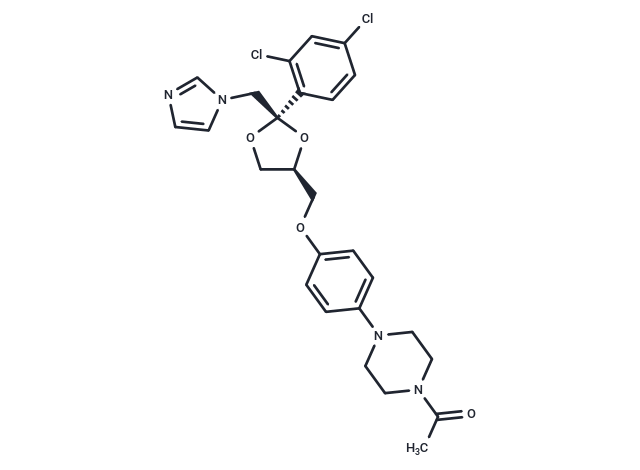Shopping Cart
- Remove All
 Your shopping cart is currently empty
Your shopping cart is currently empty

Ketoconazole (R-41400), a CYP3A4 inhibitor, is an imidazole anti-fungal agent.

| Pack Size | Price | Availability | Quantity |
|---|---|---|---|
| 50 mg | $33 | In Stock | |
| 100 mg | $46 | In Stock | |
| 200 mg | $57 | In Stock | |
| 500 mg | $72 | In Stock | |
| 1 g | $97 | In Stock | |
| 5 g | $367 | In Stock |
| Description | Ketoconazole (R-41400), a CYP3A4 inhibitor, is an imidazole anti-fungal agent. |
| Targets&IC50 | Cyclosporine oxidase:0.19 mM, Testosterone 6β-hydroxylase:0.22 mM |
| In vitro | Intraperitoneal administration of Ketoconazole (25 mg/kg) in rats significantly reduced plasma corticosterone levels and decreased self-administration of low doses of cocaine. Rats treated with Ketoconazole exhibited enhanced bioavailability of digoxin, increasing from 0.68 to 0.84, with the mean absorption time decreasing from 1.1 h to 0.3 h. Moreover, the oral area under the curve (AUC) for digoxin increased from 63 mg·h/L to 411 mg·h/L, while the intravenous AUC also rose from 93 mg·h/L to 486 mg·h/L. |
| In vivo | In HT29-S-B6 colorectal cancer cells, Ketoconazole decreased cell proliferation and [3H]thymidine uptake in a dose-dependent manner, with an IC50 of 2.5 mM. Ketoconazole also inhibited [3H]thymidine uptake in both Evsa-T and MDA-MB-231 cell lines, with respective IC50 values of 2 μM and 13 μM. Within 24 hours, Ketoconazole induced a dose-dependent reduction in the S-phase cell population (from 17% to 3%) and a corresponding increase in the Go-G1 phase cell percentage (from 64% to 80%) in HT29-S-B6 cells. By competitively binding with [3H]Dexamethasone, Ketoconazole inhibited fibroblast glucocorticoid receptors, with an IC50 of 0.3 mM. Several Aspergillus species were sensitive to Ketoconazole, with a minimum inhibitory concentration of 0.03 μg/mL. |
| Kinase Assay | Whole Cell [3H]R1881 Binding Assay: Fibroblasts are grown to confluence in five or six 150 cm2 tissue culture flasks for routine assay. This usually requires 4-6 weeks from the time of the initial seeding of the cell line. All studies are performed between passages 3-20. Two days before assay, the medium is changed to one lacking fetal calf serum. This is repeated again 24 hours before assay. Competition assays are performed with 0.5-1.0 nM [3H]R1881 and increasing amounts of the nonradioactive compounds. Binding to low affinity sites is determined in the presence of 5 × 10-7 M R1881 and is subtracted from whole cell binding of [3H]R 1881 obtained in the absence of any inhibitor to assess binding to 5 high affinity site |
| Cell Research | HT29-S-B6 cells (5×105) are plated in 35-mm Petri dishes. The next day, the medium is changed and effectors are added in a small volume (10-20 μL). The incubation medium is renewed every day during the experiments. The same triplicate dishes are used for cell counts, [3H]thymidine incorporation, and flow cytometry. [3H]Thymidine (0.5 μCi) is allowed to incorporate for 24 hours; at the end of incubation, cells are rinsed with 1 mL of medium, detached with 1 mL of trypsin-EDTA, and diluted (1:3) with the culture medium. An aliquot (0.5-1 mL) is used for cell count with a Coulter Counter.(Only for Reference) |
| Alias | Xolegel, R-41400, Extina, (±)-Ketoconazol |
| Molecular Weight | 531.43 |
| Formula | C26H28Cl2N4O4 |
| Cas No. | 65277-42-1 |
| Smiles | C([C@]1(O[C@@H](COC2=CC=C(C=C2)N3CCN(C(C)=O)CC3)CO1)C4=C(Cl)C=C(Cl)C=C4)N5C=CN=C5 |
| Relative Density. | 1.4046 g/cm3 (Estimated) |
| Storage | Powder: -20°C for 3 years | In solvent: -80°C for 1 year | Shipping with blue ice. | |||||||||||||||
| Solubility Information | 10% DMSO+40% PEG300+5% Tween 80+45% Saline: 0.53 mg/mL (1 mM), In vivo: Please add the solvents sequentially, clarifying the solution as much as possible before adding the next one. Dissolve by heating and/or sonication if necessary. Working solution is recommended to be prepared and used immediately. DMSO: 5.31 mg/mL (10 mM), Sonication is recommended. | |||||||||||||||
Solution Preparation Table | ||||||||||||||||
DMSO
| ||||||||||||||||

Copyright © 2015-2024 TargetMol Chemicals Inc. All Rights Reserved.